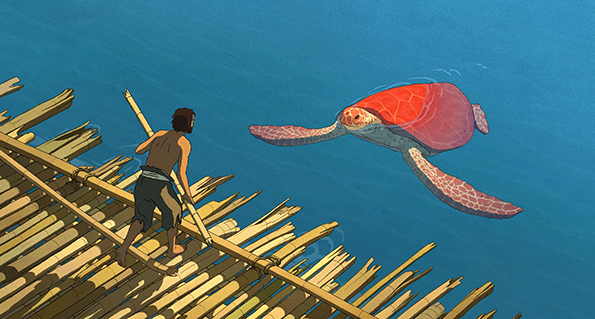In cinemas nationwide now.
The Red Turtle is an animated feature from the famed Japanese animation house Studio Ghibli and Dutch animator Michael Dudok de Wit that compares to the work of the studio’s most renowned director Hayao Miyazaki, both in the high quality of its animation as well as its emotional substance. The film tells the wordless story of a man stranded on a deserted island whose attempts to escape the island are disrupted by an unknown force later revealed to be a large red turtle. Enraged, the man kills the turtle, but awakens to find that the turtle has transformed into a woman with long red hair. The remainder of the film follows the experiences of the man, woman and their son on the island, as well as their son’s desire to leave the island and discover the world beyond.
The animation is visually stunning, featuring atmospheric shots of the mountainous landscape of the island with its cliff-tops as well as its deserted beaches and the alternately calming and treacherous surrounding waves. The visuals also take on a surreal quality, most notably in their depiction of the man’s early hallucinations of a recurring string quartet appearing on the beach, along with his son’s later dream of leaving the island, which is represented by his scaling of a large green ocean wave as if it were a mountain. The fluidity of physical movement associated with Miyazaki can also be seen in well-staged sequences showing the family scaling mountain,s and jumping from peak to peak with a finesse that rivals Renaissance-era Disney productions such as Tarzan.
The film’s character development is also effectively depicted despite the lack of dialogue, with the earlier scenes representing the man’s isolation by utilising wide shots that show him as a lone figure dwarfed by the island’s landscape, followed by latter scenes focusing on the family working together to survive on the island, as well as the intimate relationship between the man and the woman. This focus on human emotions at the expense of child-pandering comic relief, with the exception of the occasional appearances by four non-anthropomorphised crabs that occasionally bother the family, helps to distinguish The Red Turtle from its more commercial Hollywood equivalents.


Comments